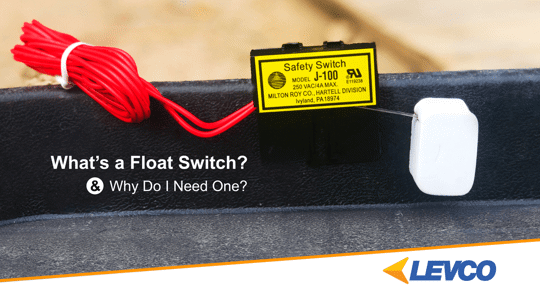One of the smallest parts of your air conditioning system happens to be one of the most important. It’s called a float switch and it protects your home from costly water damage.
Why is a float switch so important?
If you’ve looked at your air conditioning system during the summer, you’ve noticed that it generates a lot of water. The water comes from the process of removing humidity from the air in the form of condensation (water). The water is caught in a primary drain pan. There’s also a secondary or emergency drip pan just in case. Depending upon the type of unit you have, a pipe or a condensate pump then directs the water away from the drain pan and outside the home to a suitable location.
What does a float switch do?
The float switch, also known as a condensate overflow switch, is designed to prevent the drain pan from overflowing if the system isn’t working properly. It is a small metal arm protruding out of the main body of the switch with a piece of foam attached to the end. The switch activates when the level of the water in the pan goes above a certain point. If there is a clog in the drain or pipe, then the float switch springs into action by sensing that the water in the pan is too high, causing the float to rise and shutting down the compressor. This prevents further damage to the system and your home!
It’s easy for the delicate arm connection mechanism to become defective or dislodged if the switch is accidentally bumped. And if the switch is not working properly, the AC unit would continue to operate. If your unit is located in the attic as many are, the excess water has nowhere to go but through your ceiling. Not good!
Are there other benefits of a float switch?
In addition to preventing water damage by turning off the compressor, the safety device also prevents mold growth that can occur if moisture spreads throughout your home. In the end, this small safety device is capable of saving you thousands of dollars in repair costs.
What should you do?
Float switches don’t always work the way they’re supposed to. Some are installed incorrectly, have accidentally been knocked out of position, or a mechanical failure caused them to trip too late to prevent a leak. There are even systems that don’t have a drain pan and float switch installed. Therefore, it’s important for the homeowner to do a simple check. A few minutes of effort can prevent serious damage.
Here’s how:
Step 1 – Locate the secondary drain pan which is located underneath the air handler. If the pan has water in it, you may already have a clog or drainage problem. Do not do the remaining steps and call Levco to have a technician perform a service call to diagnose the issue.
Step 2 – If there is no water in the pan, locate the float switch and verify that it is mounted to the side of the pan. The switch is usually located on the same side as the air handler’s access doors.
Step 3 – Check the movement of the float arm on the float switch. It’s a small metal arm with a piece of foam attached to the end. The arm connection is delicate so handle it carefully. The arm could be defective if it doesn’t lift easily or makes a clicking sound when it nears the top.
Step 4 – Lift the float arm while the system is running and hold it for at least 1 minute. Some systems have an internal time delay on the blower and will continue to run for 30 seconds to 60 seconds after receiving a signal to turn off. If the system fails to shut down, the electrical section of the switch is defective. If the system has shut itself down properly, return the float switch to the lowest position. The unit should reset and turn back on within 5 minutes.
Should I have a Wet Switch or Float Switch?
A common alternative to the float switch is a wet switch, which also detects when condensate water overflows. Most HVAC professionals now recommend upgrading to a wet switch. A wet switch contains a sensor that shuts down the AC when only a drop of water touches it, while a float switch is only triggered when the drain pan is full. This shuts the system down faster, giving it less time to damage itself or your home! And a wet switch is harder to install incorrectly or to accidentally bump out of position. Though it costs a little more than a float switch, it’s worth it.
If your switch is missing, defective, or if you want to upgrade to a wet switch, call Levco today or request an appointment. Our trained technicians can diagnose any problem and install the part that best suits your system and needs.
Stay up to date with Levco by following us on Facebook, where we post home & energy tips for homeowners in Fairfield County, Connecticut.
Post Views: 9,153
LEVCO’s MISSION
TO SOLVE PROBLEMS FOR OUR CUSTOMERS, OFTEN BEFORE THEY EVEN KNOW THEY HAVE THEM – YOU CAN LEAN ON US!
Levco is the premier provider of heating & cooling service as well as fuel oil and propane delivery in Fairfield County, CT.
–
CT Lic. 303607
HOD 194 / DOT 663660
Copyright © 2022 Levco Tech Inc. All Rights Reserved
55 Merritt Blvd, Trumbull, CT 06611
Phone: (203) 533-8249
Email: service@levcooil.com

